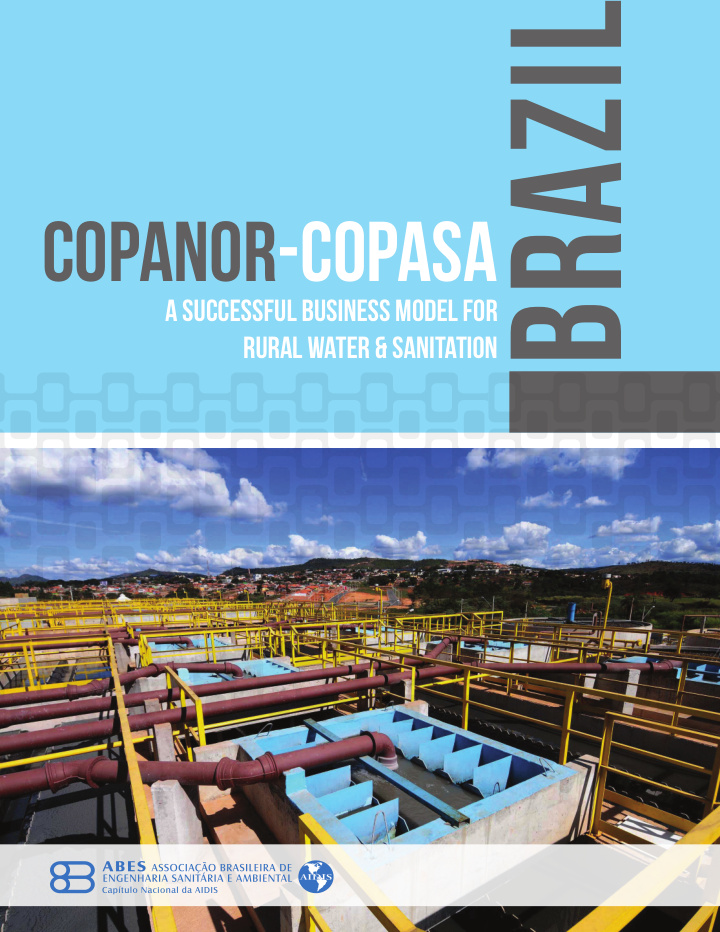



BRAZIL COPANOR-COPASA A SUCCESSFUL BUSINESS MODEL FOR RURAL WATER & SANITATION
MINAS GERAIS WATER SANITATION MAKING WATER AND SANITATION AFFORDABLE AND SUSTAINABLE COPANOR-COPASA Today, COPANOR – COPASA’s successful and innovative busi- ness model shows that countries can deliver water and sanita- tion services cost efgectively to small towns and rural areas. In 2006, the State Gov- W hile Minas Gerais is for sewage a month per household, ernment declared its located in Brazil’s most depending on the kind of supply and intention to deliver developed region – the treatment systems used. Moreover, universal water and Southeast – COPANOR’s service area while 8.28 percent of households ser- covers one of the poorest pockets of viced typically do not pay their bills, sewage (W&S) services poverty. Tie semi-arid area serviced recent effjciency improvements and throughout Northeast- by COPANOR – the Jequitinhonha, stafg reductions have helped the com- ern Minas Gerais. The Mucuri, São Mateus, Buranhém, Itan- pany generate profjts in the amount of following year, the hém, and Jucuruçu valleys combined R$4,046,000 in 2013. State authorized hold- – averages a Human Development ing company COPASA Index (HDI) of only 0.651. DEPLOYING APPROPRIATE to create COPANOR TECHNOLOGIES FOR LOCAL as a separate, wholly- Providing cost-efgective services is CIRCUMSTANCES owned company in thus critical, and COPANOR’s innova- tive business model relies on the State COPANOR’s water supply stems order to plan, design, Budget to fjnance fjxed cost overhead, from both surface and underground implement, expand, meaning that large infrastructure as- sources – either from surface areas remodel, and explore sets are not included in COPANOR’s such as streams, rivers, and dams or new possibilities for balance sheet. Hence, the company from wells accessed by either deep public water supply does not need to charge consumers a tubes or through excavation, where and sanitation in towns rate that reimburses the company for the water supply is shallow enough. and rural areas in those fjxed assets. Rates average only Water treatment technologies depend Northern Minas Gerais. about R$ 13.14 for water and 8.80 on the source, but systems usually use 2
Stafged by 311 professionals, COPANOR provides almost 83,000 water connections to about 45 Municipalities and 202 rural sites, as well as nearly 35,000 sewage connections to about 29 Mu - nicipalities and 64 rural sites. either simple chlorination for wells use either UASB treatment – either or more robust treatment methods anaerobic fjlter, polishing pond, or for surface water, such as fmoccula- biological fjltering with secondary tion, sedimentation, and fjltra- clarifjcation – or “optional ponds,” tion combined with chlorination. which are sometimes combined Treatment systems use compact, with polishing ponds. prefabricated fjltration units (see photos below) in order to deliver COPANOR deploys two kinds of continuous service 24 hours a day, sewage services, depending on the and COPANOR meters all con- size and density of the location nections to determine monthly and the absorption capacity of the consumption. soil. More densely populated areas have home service with collec- Sewage systems use either a tion networks and treatment units “dynamic” networked collective with effmuent controls. In smaller system where wasted is treated, and less densely-populated areas as well as an “anstatic” system where soils allow, COPANOR helps for individual homes and loca- equip homes with sump and drain tions, with septic tanks and sinks. technologies through a COPANOR Likewise, the networked sewage investment program. system uses difgerent technologies for treatment, depending on local characteristics. (Dynamic systems
Recommend
More recommend